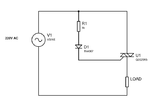jean12
Advanced Member level 2
Hello there,can you please help me to control a triac in ccs c for powering a heater resistances and control its temperature.
For temperature reading there is no problem but with TRIAC control with zero crossing,this is a great for me ,can you please help me to do that in ccs c;Tahmid has didi in MikroC but I don't know how to use MikroC,https://tahmidmc.blogspot.com/2013/06/ac-power-control-with-thyristor-pulse.html and https://tahmidmc.blogspot.com/2013/07/ac-power-control-with-thyristor.html
Please help.
Thanks.
For temperature reading there is no problem but with TRIAC control with zero crossing,this is a great for me ,can you please help me to do that in ccs c;Tahmid has didi in MikroC but I don't know how to use MikroC,https://tahmidmc.blogspot.com/2013/06/ac-power-control-with-thyristor-pulse.html and https://tahmidmc.blogspot.com/2013/07/ac-power-control-with-thyristor.html
Please help.
Thanks.
